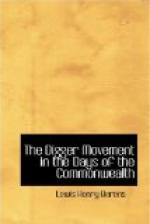For many centuries prior to the Reformation the English people had been jealous and impatient of all ecclesiastical power, as of all foreign interference in their national affairs, more especially of the claims and pretensions of the Papacy. In England, as in Germany and even in France, the idea of a National Church controlled and administered by their own countrymen, and freed from the supremacy of the Church and Court of Rome, was one familiar even to devout Catholics. Moreover, the teachings of Wyclif had sunk deep into the hearts of the people, and only awaited a favourable opportunity to yield their fruits: already in the fourteenth they had paved the way for the Reformation of the sixteenth century. Hence it was that when Henry the Eighth, from purely personal and dynastic reasons, became involved in a quarrel with the Pope, he found his subjects prepared for greater changes in religious matters than any he contemplated or desired. However, by a series of legislative enactments, the Church of England, in 1534, was emancipated from the superiority of the Church of Rome; the papal authority was wholly abolished within the realm; Henry was legally recognised as the supreme head of the Church of England; the power of the spiritual aristocracy was broken and the whole body of the clergy humbled; the monasteries were suppressed; the great wealth and vast territorial possessions of the Church became the prey of the Crown, only to be dissipated in lavish grants to greedy courtiers: and thus the foundations were laid for greater changes in both Church and State than those who promoted such measures ever dreamed of.
From its inception the Church of England comprised two opposing and apparently irreconcilable elements, namely, those whose sympathies and leanings were toward the forms, dogmas and doctrines of Roman Catholicism, and those whose sympathies and leanings were toward the forms, dogmas and doctrines of the German and Swiss Reformers. Of religious toleration both parties were probably equally intolerant. That the State was directly concerned with the religious beliefs of the people, hence was justified in enforcing conformity to the Church as by law established, seems to have been unquestioningly accepted by both. The one desired to make use of the temporal power to prevent, the other to promote, further changes in Church government, worship and doctrine. The result was a compromise, which, like most compromises, satisfied the more logical and consistent of neither party. As ultimately established, in the reign of Elizabeth, the Church of England occupied a sort of middle position between the Church of Rome and the Reformed Churches of the Continent; and the attempt to enforce conformity to its demands resulted in the separation from it of the extremists of both sections. On the one hand, the English Roman Catholics became a distinct and persecuted religious body, whose members were generally regarded, despite repeated evidence




